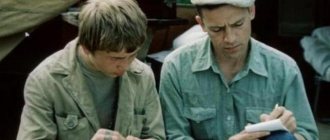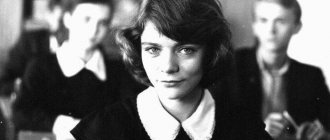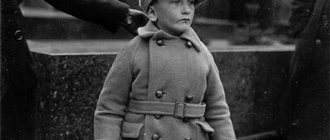Childhood
Arkady Petrovich was born on January 9 in the city of Lgov, located in the Kursk province. His father worked as a teacher at a local school, and his mother, a noblewoman by birth and a distant relative of Mikhail Yuryevich Lermontov himself, was a paramedic, having completed medical courses immediately after high school. Both of Gaidar’s parents were revolutionaries and took part in the protests of 1905, so they were forced to hide from the authorities and live away from the capital.
In 1912, Arkady's father was sent to Arzamas, where the situation was seriously deteriorating due to constant revolutionary movements against the existing government. His mother is traveling with him as the local hospital is also asking for more volunteers to provide medical care. So, Gaidar travels with his parents to Arzamas, where he lives until the end of the First World War.
By the way, he is also trying to help his father, who is sent to the front two years later. A little boy takes refuge in one of the military vans en route to the border with new soldiers, but halfway through the journey he is discovered and sent back to Arzamas.
Son - Yegor Gaidar
When Timur Arkadyevich Gaidar, whose biography connects the history of two famous families, was a war correspondent in other countries, his wife and son always traveled with him. As son Yegor recalled, life in Cuba was especially memorable and vibrant. His father, according to him, knew Raul Castro and Ernesto Che Guevara quite well, and communicated with them “at close quarters.” Several times little Yegor visited military units and garrisons with his father, where he was allowed to climb tanks and armored personnel carriers.
Brothers Nikita and Yegor have always been very friendly, despite the fact that the age difference was quite large - 10 years. Egor, having lived abroad for a significant part of his childhood, read a lot. Books were available to him that were not available in the Soviet Union. I studied well. Only, as his mother admitted, he had very bad handwriting since childhood. It is not surprising, because among all representatives of the Gaidar family it was terribly sloppy and illegible. Egor learned several foreign languages during his school years. Despite the fact that Yegor’s grandfather was the famous writer Arkady Gaidar, and his father was the famous military journalist Timur Gaidar, his biography (see family photo below) is not related to literature. He entered politics. His mother was ambivalent about his desire to build a political career. In one interview, she expressed the opinion that it was politics that caused his early death. The ambiguity of the state system of the 90s, which marked the peak of Yegor Gaidar’s activity, caused many contradictions, which affected not only his professional life, but also his health.
He was first married to his childhood friend Irina Mishina, and entered into a second marriage with the daughter of the famous science fiction writer Arkady Strugatsky, Maria.
Youth and military service
At the age of 14, the revolutionary-minded Arkady was accepted into the Communist Party. From that moment on, his life takes on a “military footing,” which the guy is sincerely happy about, because he wants to be like his father.
Thanks to his active life position and self-confidence, Gaidar was accepted into the ranks of the Red Army, and a year later he went to command training courses, which were being held at that time in Moscow.
Having studied in the capital, he first became an assistant platoon commander, then an independent regiment commander and, ultimately, a battalion commander.
With his soldiers, whom, by the way, Arkady Gaidar took better care of than other officers, he is present on several fronts of the Civil War, where he wins many victories. Unfortunately, during one of the final battles he is wounded, and while trying to get to the command post, he receives a severe concussion.
In February 1922, Gaidar returned to service and, as a regiment commander, was stationed in the Yenisei province, where he was tasked with dealing with local “bandits”, whom, in his opinion, were supported by most of the population. However, after a severe shell shock during the Civil War, Arkady began to have problems with alcohol, which he never admitted to anyone. While intoxicated, he made a number of mistakes, including ordering his soldiers to shoot several “bandits” while trying to escape. By the way, Gaidar did not spare his own guys.
After a small quarrel with the commander, several people were sent to headquarters without personal belongings, which the battalion commander confiscated as punishment. This behavior caused discontent, a criminal case was opened against Gaidar, and on August 18, 1922 he was removed from military service without the right to appeal.
[edit] About Arkady
| « | Gaidar, kill your grandson! | » |
| — Request of a grateful note | ||
Gaidar is ahead!
There was one, Yegor’s grandfather. He became famous for the fact that at a young age he commanded a regiment, albeit a reserve one. But he successfully fought against the Tambov “Antonovism”. Antonovshchina was cut out by the Red Army, so wine. Then, while still a child (18 years old), he was sent by the party and government to the area of the Yenisei River. Where he imposed Soviet power with floggings, executions and gallows. The facts are in pedivikia, welcome. And as for the Lulz, even the bloody Gebnya was so freaked out by Gaidar’s actions that they actually deprived him of his commanding powers and recalled him to Moscow. Why not lulz?
Then Gaidar, who after the Yenisei was no longer allowed to command anything, began, firstly, to become an alcoholic, secondly, to lie in Moscow psychiatric hospitals many times, and thirdly, to write fiction books for children! The writer Paustovsky, with whom the subject was friends, describes his schizoid attacks very well. Running around the apartment with a shoe knife after your best friend is an ordinary option. Then, however, he apologized. Oldfags, watched “R. V.S.” on the zombie box as a child? The author is him. “The fourth dugout” is also him. And about military secrets - he again. Malchish-Kibalchish, together with Plokhish and the Main Burzhuin - we studied this work already in kindergarten, but few people remember that the author is Gaidar. And Timur and his team are him again. And the vintage, but now half-forgotten, “Bumbarash”.
- In the book “In One Happy Childhood” he is actually the protagonist - (spoiler:
once in the village, Arkady Gaidar shouts “I invented you, grandma,” after seeing how fiercely the grandmother in the village unwittingly cosplays the grandmother from his book.
) ( spoiler:
Finally and completely, cutting off the story itself, the boys finish off Arkady, introducing themselves only as “We are Timur’s men.”
)
Also, during the Second World War (which was under Stalin, and not where the 80-lvl elves are running around), this writer was a front-line correspondent for the newspaper “Komsomolskaya Pravda”, he wrote “notes from the front” for peaceful cherished citizens, in the process of writing which he was cut out by the Nazis.
Creation
Realizing that he would no longer be an officer, Gaidar began to write short stories. The debut work is “In the Days of Defeats and Victories” (1925), which the writer asks to publish in the then famous almanac “Bucket”. But after a week, he realizes that the story was too weak to qualify for positive reviews from readers and literary critics. The story was completely criticized, and Gaidar was even advised not to engage in literary work anymore, with which he, of course, categorically disagreed.
In 1932, Arkady Gaidar travels to the Far Eastern region and gets a job at the famous newspaper Pacific Star. Since the organization could not provide full-time vacancies at that time, they offered Arkady the position of special correspondent, which implied constant travel to other cities. Gaidar happily agrees, and for a long time publishes his articles in the newspaper on the development of livestock farming, agriculture, horticulture, etc.
At the same time, Gaidar began the most fruitful period of his life. He enjoys writing children's novels and short stories, which turn out to be incredibly interesting and not too naive. Thus, the result of his work are such works as “School” (1930), “Distant Countries” (1932), “Military Secret” (1935), “Chuk and Gek” (1939), “Timur and His Team” (1940 ) and many others. They became the heritage of Russian literature and are still popular and in demand to this day.
Arkady Petrovich Gaidar
Slide 2.
The life of Arkady Gaidar is full of paradoxes. She herself is a paradox.
Slide 3.
For starters, the roots. On the side of his father Pyotr Isidorovich, the Golikovs are peasants. And my mother, Natalya Arkadyevna, nee Salkova, was Lermontov’s sixth great-great-great-great-niece. The connection is not direct, but symbolic.
Slide 4.
Arkady Golikov (Gaidar is his literary name) learned to read early, early learned the names of those who wrote the most interesting books - Alexander Pushkin, Mikhail Lermontov, Nikolai Gogol, Leo Tolstoy, Jules Verne...
But Arkady not only read a lot. He liked to perform on the stage of the “home theater”, which was organized by the Golikovs’ neighbor, teacher Tatyana Ivanovna Babaykina, at school amateur art evenings. One day he read an excerpt from “Peasant Children” by N.A. Nekrasova. None of the students at the real school were applauded as loudly as he was. Even the strict literature teacher (that’s what literature classes were called back then) smiled and said to his neighbor: “The boy is well prepared, he knows a lot about poetry. But I met him on the street more than once and thought that the daredevil didn’t even hold good books in his hands.”
Arkasha's childhood, with his usual boyish activities - real school, games, first poems, "sea battles" on the pond - coincided with the First World War and the revolution. He called this time fun. Dreams came true - you could easily exchange a revolver at the market, hear revolutionaries - Socialist Revolutionaries, Cadets, Bolsheviks - live. Fourteen-year-old Golikov joined the latter, becoming perhaps the youngest member of this party. But it was no longer a game. He believed in a new wonderful life and went to protect it.
Over the course of four military years, he went from adjutant to regiment commander. Colonel at seventeen! Even the young officers of 1812 did not know such a career. They fought for the Fatherland, against a foreign enemy, and Golikov fought with his own people - the Russians. The civil war, no, a real military war, brought so much shock and pain. Wounds, shell shock, bivouac life, cruelty, blood were not in vain for such a sensitive and proud young man as Arkady. The result was a severe nervous illness that haunted him all his life and forced him to leave the army. But the life experience accumulated during the civil war draws Arkady to writing. The first publication dates back to 1925. The magazine “Star” published the story “In the Days of Defeats and Victories.” This was the name of Golikov’s first story, but not yet of Gaidar’s. Signed "Ark. Gaidar" appeared and became famous on the pages of the Perm newspaper "Zvezda". This sonorous name took root so much that it became a surname.
To use the expression of Gaidar’s beloved Gogol, he “traveled around Russia” to his heart’s content. And not only for her. In 1926, Gaidar and his friend made a carefree and arrogant trip to Central Asia. Later, as a newspaperman in Arkhangelsk, he dictates correspondence from aboard the French ship Saida in distress.
Slide 5.
The meeting of Velichkin readers with Arkady Gaidar is preserved in the history of the Rostov Regional Children's Library as one of the most striking, unforgettable episodes.
In 1934, a regional meeting of children's library workers was held in Rostov, in which A.P. took part. Gaidar. He then performed in several children's libraries, including the library named after. V.M. Velichkina, read excerpts from the story “Military Secret”, then left the manuscript for library readers. The guys read the story and wrote a letter to Arkady Petrovich, in which they expressed their dissatisfaction with the death of the hero, Alka. In a heartfelt and memorable letter to readers of the Rostov library. V.M. Velichkina, answering their questions, the writer shared: “Of course, it is better for Alka to remain alive. Of course, it is better for Chapaev to remain alive. Of course, it would be immeasurably better if thousands and tens of thousands of big, small, famous and unknown heroes remained alive and well. But this doesn’t happen in life... You feel sorry for Alka. Some guys write to me in their review that they are even “very sorry.” Well, I’ll tell you frankly that when I was writing, I myself felt so sorry that sometimes my hand refused to finish writing the last chapters. And yet it’s good, which is a pity. This means that you, together with me, and I, together with you, will love even more deeply the Soviet country in which Alka lived, and our foreign comrades, those who were thrown into hard labor and prison. And we will hate all our enemies even more: both our own, at home, and strangers, foreign - all those who stand across our path, and in the fight against which our best big and often small comrades die. Here is the answer to the first question.
“Why “Military Secret”? Of course, according to a fairy tale. Bourgeouin asks three questions: the first of them is whether the victorious Red Army has any special military secret or the secret of its victories? Of course, there is a secret, but the main Burzhuin will never understand it. It's not just about weapons, guns, tanks and bomb carriers. The capitalists have a lot of all this. The fact is that she is deeply convinced of the rightness of her struggle. The fact is that it is surrounded by the enormous love of millions of the best proletarians of capitalist countries... And this is the Red Army - also its own military secret. Here is the answer to the second question.
With this letter, in order not to repeat myself, I immediately answer the library guys. Velichkina and Lomonosov. Warm greetings to everyone - Mitya Belykh, Vita Zaraisky, Alekseev, Podskorin, Richter, Valya Cherednichenko and in general to everyone who has a smart head on their shoulders.
I'm alive and well. I live in the mountains now. Arzamas, I’m working, I’ll stay here for a few more months. In the fall, I will probably be in the Caucasus and then, perhaps, we will meet again for a day or two. Stay safe and healthy, too.
Your Arkady Gaidar. March 5, 1935 Arzamas
».
Letter from A.P. Gaidar was published in the magazine “Pioneer” in 1940. The original letter of the writer to library readers, unfortunately, was lost during the occupation of Rostov by the Germans.
Slide 6.
Son of the Soviet writer Arkady Petrovich Gaidar (Golikov). The famous story by Arkady Gaidar “Timur and His Team” was associated with his name.
Timur Gaidar graduated from the Leningrad Higher Naval School in 1948, the Faculty of Journalism of the Military-Political Academy named after. Lenin in 1954. He served on a submarine in the Baltic and Pacific fleets. Later he worked for the newspapers “Soviet Fleet” and “Krasnaya Zvezda”, and since 1957 - for the newspaper “Pravda”, where he was editor of the military department, his own correspondent in Cuba, Yugoslavia, and Afghanistan. He also published in Moscow News and Izvestia, and was a member of the editorial board of Pioneer magazine.
Timur Arkadyevich Gaidar was an Honorary Guest and an active assistant of the Moscow Palace of Pioneers and Schoolchildren named after. A.P. Gaidar, located in the Moscow Tekstilshchiki district.
Slide 7.
During the Great Patriotic War, Gaidar was in the active army, as a correspondent for Komsomolskaya Pravda. He was a witness and participant in the Kyiv defensive operation of the Southwestern Front. He wrote military essays “At the Crossing”, “The Bridge”, “At the Front Line”, “Rockets and Grenades”.
Slide 8.
After the encirclement of the Southwestern Front near Kiev, in September 1941, Arkady Petrovich ended up in Gorelov’s partisan detachment. He was a machine gunner in the detachment. On October 26, 1941, near the village of Leplyavoya in Ukraine, Arkady Gaidar died in battle with the Germans, warning members of his squad about the danger. In 1947 he was reburied in Kanev.
Slide 9.
In 2014, the story “The Fate of the Drummer” turns 75!
The story “The Fate of the Drummer” was written by Gaidar in 1938. She talks about the severe trials that befell the thirteen-year-old boy Serezha Shcherbachev, a drummer in a pioneer detachment. The boy is proud of his father, who fought for the revolution. But my father was arrested for embezzling government money. The boy dreamed of being a brave drummer soldier, like the little French hero he read about, but, having lost his sense of inner responsibility for his actions, he makes a series of mistakes that lead him to meet criminals.
The plot is based on an acute conflict that helps reveal the inner world of the main character. The rapidly developing action is psychologically justified: the chain of mistakes and delusions of the boy, left without relatives, without the kindness and trust of others, grows. In the tone of the story, the motive of anxiety for the fate of the child sounds more and more strongly. The author traces how day after day the main ethical standards are destroyed in Seryozha’s life. The plot develops from episode to episode more and more intensely, in some places approaching a detective story. However, the detective elements are subordinated to the main theme of the work - the theme of education. In “The Fate of the Drummer,” Gaidar uses the form of a first-person story, which allows him to show the hero’s experiences and give his self-esteem without resorting to the author’s commentary. This is a boy's sincere story about his mistakes and delusions.
The hero's internal monologues, observations and reflections are combined with images of him in action. Believing in his hero, Gaidar psychologically accurately shows the “straightening” of the young drummer. What won in the teenager was the feeling of unity with his native country, the memory of his father’s “good soldier’s songs” and the “yellow meadows with dandelions” where many Red Army soldiers died. The feeling of a revolutionary connection with all the people awakened in Seryozha the desire to live like everyone else, to “directly and openly” look people in the eyes.
The drummer's romantic theme runs throughout the story; it reaches its climax in one of the last scenes of the story: “And a sound rang out, clear, even, as if someone had struck a large melodious string and it, delighted, untouched for a long time by anyone, trembled and rang, striking the whole world with the amazing purity of its tone. The sound grew and grew stronger, and with it I grew and grew stronger.
“Straighten up, drummer! The same voice already warmly and affectionately told me: “Get up and don’t bend!” The time has come!
In Seryozha’s internal dialogue, the fearless drummer wins, and the boy at a crucial moment becomes a fighter who does not put up with the fact that bandits and spies “go wherever they want” before his eyes. The climactic scene of the story - the straightening of the drummer - is resolved by romantic means, and this gives it high emotionality.
Arkady Gaidar: “I write mainly for youth. My best reader is ten to fifteen years old. I love this reader, and it seems to me that I understand him, because relatively not so long ago I myself was the same teenager.”
Slide 10.
The story “Chuk and Gek” (1939) will also celebrate its 75th anniversary this year! This story, like “The Blue Cup,” was not immediately understood by critics, but was immediately accepted by the children. Not years, but decades have passed, and works that at one time seemed to some critics “largely controversial”, “elementarily simple in plot”, “compositionally uncoordinated”, “incomprehensible” for children’s readers, live in the memory of contemporaries of their first editions and in reading those who are growing up now. These “elementarily simple in plot” stories are not so simple, and the poetic charm of the same “Chuk and Huck” is not only in its “artlessness” or in the fact that “the world is shown through the prism of children's perception.” The writer’s creative concept is deeper, the external “artlessness” and “simplicity of the plot” reflect the richness and complexity of life. This is the simplicity of great talent, and not the primitiveness of the vision of the world.
Chuk and Gek are two brothers, and each has his own habits, a manner of behavior peculiar only to him and the logic of the development of thoughts. It doesn’t matter that so far these thoughts are not very significant, for example, how best to deal with the disappeared telegram. Should I tell my mom the truth about my tricks or come up with something? After all, “this mother had a strange character,” and for a fight, she “separated the fighters into different rooms and for a whole hour, or even two, did not allow them to play together.”
And Chuk suggests not talking about the telegram at all. But Huck is more careful; he remembers that “you can’t lie,” because “mom always gets even worse angry for lying.” So Huck makes a discovery that is not so “simple” and “ingenuous”, that lying is dangerous, and that’s all. If you convince yourself that a lie is not a lie at all, and therefore there should be no punishment, then you can lie. The writer does not soften the theme of lies and truth, but puts it in all its severity.
“Chuk and Gek” is a story about the meaning of human life, about happiness, about love for the Motherland. “Everyone understood this in their own way what happiness is. But all together people knew and understood that they had to live honestly, work hard and love and take care of this huge happy land, which is called the Soviet country,” these words of Gaidar contain the main idea of the story. A huge and kind world opens up before the brothers during a trip from Moscow to the east, to the Blue Mountains. The fairytale beginning of “Chuk and Gek” (“There lived a man in the forest near the Blue Mountains”) determines the entire intonation structure of the story. Events, episodes, incidents are presented in it in the emotional refraction of the perception of Chuk and Gek.
And when you start reading with the enchanted phrase: “Once upon a time there lived a man in the forest near the Blue Mountains...” - your heart warms because you anticipate the pleasure of further exciting events, from Gaidar’s radiant prose, from the feeling of happy delight that is so characteristic of childhood and which over the years it comes less and less often. Real events take on a fairy-tale coloring, are complemented by fiction, and become poetic: “It was an amazing walk! They walked in single file to the spring along a narrow path. The cold blue sky shone above them; Like fairy-tale castles and towers, the pointed cliffs of the Blue Mountains rose towards it.”
Gaidar’s plan to write a story “as bright as a pearl” was fully realized. Poetry, emotionality, humor, clear lyrical subtext are the characteristic features of this work, which conveys with amazing power the feeling of happiness in life and love for the Motherland. V. Shklovsky’s remark in connection with the appearance of the stories “Chuk and Gek” and “The Blue Cup” about the lyrical understanding of life by A. Gaidar, about his new voice, that this new in Gaidar’s manner did not cease to make the writer understandable and beloved children."
Konstantin Paustovsky: “Arkady Gaidar was rightfully a heroic and legendary man. He was courageous and faithful to his work - writing. He had a light, winged, inexhaustible imagination. The power of his imagination did not fit entirely into the pages of his books. The excess of this power seemed to spill out into everyday life, filling it with joy, making this everyday life extraordinary.
Life with Gaidar always promised surprises. Obviously, this is why children seriously considered him a wizard, and adults were amazed at his insight.
Most people do not know how to treat children as equals. Gaidar knew how to do this. He saw right through any village boy with all his dreams and hobbies, with his wild joy, thirst for activity and simple-minded cunning.
The children did not lag behind him, following him as if they were a leader and best friend. They were proud of him and unquestioningly obeyed his orders, always accurate and reasonable..."
Slide 11.
The old house on Gorky Street, whose age has already passed the century mark, is familiar to everyone in Arzamas - children's writer Arkady Gaidar lived here with his family from 1912 to 1918. In those years, the writer himself was still a child, but it was here that the foundations of his future work were laid, which subsequently influenced the development of an entire generation. The house-museum still preserves the interiors of the early twentieth century, in which the family of the famous writer lived. The house has four rooms - a living room, a parents' room, a kitchen and a children's room. In these rooms you can see things whose value lies not only in their involvement in Gaidar’s life. On an antique chest of drawers in my parents’ room there is an elegant rectangular carriage clock. Even in those years, a hundred years ago, this watch was considered a real family heirloom. The kitchen is an excellent example of the everyday life of the early 20th century: a large Russian stove, a copper washbasin, a samovar. And in the children's room there is the same table where little Arkady first learned to write letters, and then, as an adult, he wrote serious letters to his father at the front. A lot of books in the house are not museum decoration. Gaidar's family really loved to read, and the books that belonged to the family are still carefully preserved.
The house-museum of A.P. Gaidar tells the story of not just one family, but an entire historical era. By communicating with museum guides, you can learn a lot about life in Arzamas during the years of the revolution and civil war. In addition to the permanent exhibition - the interiors of the house, there are other exhibitions related to the history of the city and neighboring regions, with museums of which there is active cooperation.
In Arzamas, the name of A.P. Gaidar was given to one of the streets, the city park of culture and recreation, school No. 7, the central city children's library, and the Arzamas State Pedagogical Institute. The ponds located in the central part of the city, where little Arkady staged his “sea battles,” are called Gaidar ponds. The building of the Real College, where the writer studied, has been preserved in the city.
Slide 12.
From 1938 to 1941, A.P. Gaidar lived in Klin, near Moscow, on Bolshevistskaya Street (now Gaidar Street). Here he wrote the works “Timur and his team”, “Smoke in the Forest”, “Commandant of the Snow Fortress”. In Klin, the Central Children's Library bears his name.
In 1989 in Klin, in the house where A.P. lived and worked. Gaidar, a museum has been opened, which displays an exhibition dedicated to his life in the Klin period.
House-Museum of A.P. Gaidara keeps many documents, photographs, books, personal belongings, and household items related to the life and work of the writer.
The memorial part of the exhibition reproduces the main stages of the writer’s biography during the Civil War. Photographs of the writer with his family and friends, the decor of the writer’s workplace and living room reveal the period of his life in Klin from 1938 to 1941.
The literary part of the exhibition introduces Gaidar’s work, lifetime editions of his works, written in Klin.
Slide 13.
The monument to Malchish - Kibalchish (literary hero) was opened on May 19, 1972, on the day of the 50th anniversary of the founding of the pioneer organization, at the main entrance to the Moscow City Palace of Pioneers on the Lenin Hills. The authors of this work are sculptor V.K. Frolov, architect V.S. Kubasov. The height of the monument is 5 meters. The monument to Malchish - Kibalchish is a sculpture of a boy made of forged copper and installed on a granite pedestal. The figure is depicted moving forward, one leg raised for a further step. The boy has a forge and a saber in his hands. There is a budenovka on his head, a shirt fluttering in the wind. The sculpture is installed on a long, elevated, sloping pedestal made of granite slabs. The sculptor found and embodied in artistic and plastic form a vivid image of youthful romance, ardor, readiness for heroism and fidelity.
Slide 14.
In the Soviet Union, Gaidar's books played a huge role in the education of younger generations. Gaidar's name was given to many schools, streets of cities and villages of the USSR.
In the Rostov region, Gaidar Street is in Rostov-on-Don and Bataysk, Gaidar Lane is in Novocherkassk and Shakhty.
10 children's libraries are named after Arkady Petrovich Gaidar:
| · Rostov-on-Don, · Aksai, · Gukovo, · Kamensk, · Zernograd, | · Azov, · Novocherkassk, · Novoshakhtinsk, · Taganrog, · Donetsk. |
The Kaliningrad and Belgorod regional children's libraries, the Kaluga central city children's library, and the central children's library of Sevastopol are named after A.P. Gaidar.
In 1978 and 1983, an artistically marked envelope dedicated to the writer was published.
Slide 15.
The most famous works of Arkady Gaidar: “PBC” (1925), “School” (1930), “Distant Countries” (1932), “The Fourth Dugout”, “Military Secret” (1935), “Timur and His Team” (1940) , “Chuk and Huck” (1939), “The Fate of the Drummer” (1938), stories “Hot Stone” (1941), “The Blue Cup” (1936). In the works of the 1930s there is glorification and romanticization of the Civil War, devotion to the ideals of the first years of Soviet power.
In the Soviet Union, the works of Arkady Gaidar were published more than 1,100 times with a total circulation of about 105 million copies in Russian, in the languages of the peoples of the USSR and foreign countries.
The writer’s works were included in the school curriculum, were actively filmed, and translated into many languages of the world. The work “Timur and His Team” actually marked the beginning of a unique Timur movement, which aimed at voluntary assistance to veterans and elderly people on the part of the pioneers. S. Marshak called Gaidar “the all-Union counselor.”
Bibliography
- Arzamastseva I. N. Gaidar A. P. / I. N. Arzamastseva, S. A. Nikolaeva // Children's literature: a textbook for students. higher and average ped. textbook establishments. – 2nd ed., stereotype. – M.: Publishing House; Higher school, 2001. – pp. 296-303.
- Gaidar Arkady Petrovich // Writers of our childhood. 100 names: biographical dictionary in 3 parts. Part 1. – M.: Liberea, 1999. – P. 102-105.
- Gaidar Arkady Petrovich//Russian children's writers of the twentieth century: biobibliographic dictionary. – M.: Flinta, Science. – 1997. – P. 113-116.
- Gaidar at school: a manual for teachers / comp. T. F. Kurdyumova. – M.: Education, 1976. – 126 p.
- The life and work of A.P. Gaidar: materials for an exhibition in a school and children's library. - M.: Det. lit., 1984. - 18 p., [23] l. ill.
- Kamov B. Arkady Gaidar. Target for newspaper killers / B. Kamov. - M.: ZAO Olma Media Group, 2011. - 544 p.
- Kruk N.V. Chuk and Gek: literary hour / N.V. Kruk, I.V. Kotomtseva // Library lessons on reading. Scenarios 1-9 grades: in 2 hours. Part 1. - M.: Russian School Library Association, 2010. - P. 179-197.
- Belyankova N. M. About the All-Russian scientific and practical conference “The role of the works of A.P. Gaidar in the patriotic education of children and youth” / N. M. Belyankova // Primary school. - 2006. - No. 10. — P. 30-31.
- Korf O. “The Fate of the Drummer” by Arkady Gaidar is 60 years old! / O. Korf // Children's literature. – 1999. – No. 4. – P. 71.
- Korf O. Arkady Gaidar's stories “Chuk and Gek” - 60 years old! / O. Korf // Children's literature. – 1999. – No. 1. – P. 57.
- Manturova L. The Tale of Prince Gaidar / Lyudmila Manturova // Children's literature. - 2004. - No. 1/2. — P. 80-82.
- Motyashov I. “...As in heaven and on earth”: [for which Gaidar lived and died] / Igor Motyashov // Children's literature. - 2004. - No. 1/2. — P. 40-78.
- Ovchinnikova I. “Chuk and Gek.” In memory of A. Gaidar (1904-1941) / I. Ovchinnikov // Books, sheet music and toys for Katyushka and Andryushka. – 2011.- No. 1. – P.12-14.
- Frolova E. A. Nomination of characters in A. P. Gaidar’s story “Chuk and Gek” as a means of revealing the family theme / E. A. Frolova // Russian language at school. - 2001. - No. 5. - P. 49-51.
- Tsvetov V. Country of dying knights: non-anniversary afterword to the 100th anniversary of Arkady Gaidar / Vladimir Tsvetov // First of September. – 2004. – February 10. (No. 11). — P. 3.
(pptx, 658 Kb)
Questions for discussion of the story “Chuk and Gek”, the story “The Fate of the Drummer”
Personal life
In 1921, Gaidar, who arrived from the front severely shell-shocked, met nurse Maria Nikolaevna Plaksina in the hospital where he was undergoing rehabilitation. Six months later they get married. The marriage produces a son, Zhenya. But later Arkady is forced to leave his wife and small child, leaving for work in another city. They actively communicate for some time, and then the young father learns about the death of his child, withdraws into himself, and the family falls apart.
At the beginning of 1920, Arkady meets journalist Liya Lazarevna Solomyanskaya, whom he marries for the second time. His wife gives him a wonderful son, Timur, but this marriage is not destined to last long. Being young and naive, Leah leaves her husband for a more promising man.
In 1938, working as a special correspondent and arriving in Klin, Gaidar stayed with the owner Chernyshev, where he met his daughter Dora. Six months later, he asks for her hand. They are getting married.
Boy from Arzamas
“Our town of Arzamas was quiet, all in gardens, surrounded by shabby fences. In those gardens grew a great variety of “parental cherries,” early-ripening apples, blackthorns and red peonies,” Gaidar later recalled in his “School.”
He was born into a family of teachers, but what kind! His mother was a noblewoman from an impoverished but ancient family, all the men in the family were officers, Lermontov himself was a relative of them. She got married against her father's will - the groom, Pyotr Isidorovich Golikov, was a serf. Gaidar’s parents equally hated the tsar and the entire tsarist regime, they were populists, took part in the revolution in 1905, and hid underground members in their home. Then they had to wander around, hiding from persecution, until they came across in their wanderings the quiet town of Arzamas, surrounded by gardens.
Arkady Gaidar (right) with his friend journalist S. Militsin
The Golikov family was endlessly respected in Arzamas: educated, always friendly, house full of books... The children - Arkady and his sisters - read all the time. Arkady - Little Kibalchish - dreamed of long journeys and exploits. When the First World War began and my father was called up, I tried to escape to the front with him. The ten-year-old cat was caught and returned to its mother.
Of course, he was a child prodigy: smart, talented, with a complex world inside, with a sacred belief in his own uniqueness. He could quote entire pages from the best books by heart. In his real school he was a leader, all the boys wanted to be friends with him.
It’s good when fate protects such a child, but this happens rarely.
Military career
After the fall of the royal family, many parties and student committees appeared in Arzamas. In the summer of 1917, Golikov received the position of delivery boy, and in 1918 he joined the Bolshevik squad. Initially, the Bolsheviks took the young man into the RCP (b) as a candidate, and 15-year-old Golikov became a full member of the party on December 15, 1918. At first he served as an adjutant, later he headed the railway security department.
The young man constantly asked to go to the front, but the commander insisted that the guy first undergo specialized training. And so it happened - Golikov went to the Moscow command courses of the Red Army. Later the institution moved to Ukraine, to Kyiv. Once in Kyiv, Arkady fought with the Petliurists and Ukrainian rebels.
In 1919, Golikov became a commander, and in 1920, a commissar of headquarters. At the age of 17, he knew more about military affairs than many commanders. In 1921 he received the rank of regimental squad commander. Golikov fought on different fronts (in Sochi, on the Don, on the Caucasus front), where he suffered from typhus, was wounded and shell-shocked twice. In 1922, he was sent to suppress the anti-Soviet uprising in Khakassia. Here the young commander showed himself to be a bloodthirsty tyrant, who disliked Jews and shot the population on suspicion of banditry.
According to historians, Gaidar pushed women and children off cliffs and killed anyone he suspected of anti-Soviet activity. In 1922, he was accused of abuse of power. Gaidar was stripped of his position and expelled from the party, and was sent for a psychiatric examination. The case ended with a diagnosis of “traumatic neurosis.”
Curious facts
More than 70 years have passed since the death of the writer. However, researchers are still arguing about its life history.
Interesting facts about Arkady Gaidar:
- The writer joined the ranks of the Red Army at the age of 15.
- Historian Andrei Burovsky gives an alternative version of Golikov’s enrollment in the Red Army. In his opinion, Arkady’s mother enlisted in the army to save him from retribution for the murder (or murders) that her son committed. Gaidar, during fits of madness, once admitted that he had committed murder in his youth: “I dreamed about the people I killed in childhood...”
Arkady Gaidar | Kursk Scientific Library
- The history of the writer’s pseudonym is also interesting. According to one version, “Gaidar” is translated from Turkic as “messenger”, “advanced horseman”. Another source claims that the pseudonym comes from the phrase “Golikov Arkady from Arzamas.” The third version reports that the pseudonym originates from the Khakass word “Haidar”, which means “where”. During the service in Khakassia, locals shouted: “Haidar-Golik is coming!”
- There is an opinion that it is not Arkady Gaidar who lies behind the gravestone in Kanev (a city in the Cherkasy region). In particular, several years after burial, the slab cracked. It was replaced with a new one, but it was also cracked.
Arkady Gaidar with his son Timur | Literary newspaper
- There is a version that Timur (the son of Leah Solomyanskaya) is not the writer’s own son, but an adopted son. The writer first saw Timur only at the age of two, and at the time of his alleged conception (April 1926) Gaidar was in Central Asia. Thus, it is possible that the writer has no blood descendants.











